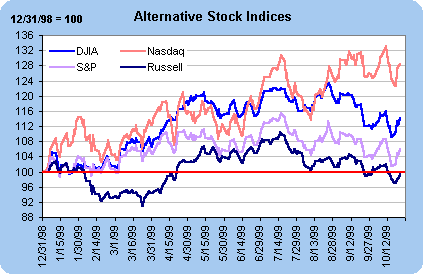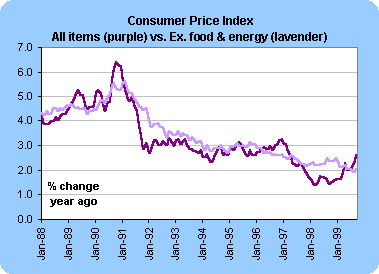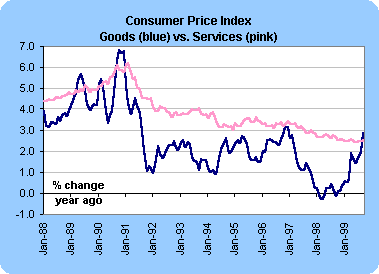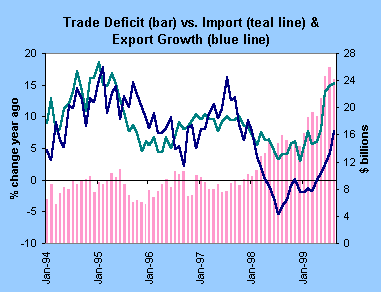
|
Today's Calendar |
| | Simply Economics |
| | International Perspective |
| | Resource Center |
 |
|
| 1999 Articles |
|
By Evelina M. Tainer Chief Economist, Econoday Corporate earnings take center stage in the equity arena
Exciting week for equities  So why are stock investors so edgy? They are worried about the uncertainty of Y2K issues, but even more concerned about the prospect of a series of Fed rate hikes. Is inflation really a problem these days? And Fed chairman Alan Greenspan talks like he has an itchy trigger finger. Thus far, the Dow has managed to close above the psychologically important 10,000 level. Looking at the year as a whole, the Dow is still showing a respectable gain. Unfortunately, many investors got in this summer as stock prices were peaking. Many stocks are down at least 10 percent from their highs, as is the Dow, which counts as a "market correction." The chart shows the continued exuberance in the NASDAQ composite. Even though this index is down from its highs, it is still 28 percent higher than yearend! One has to admit this is a phenomenal run. The S&P 500 is only 5.9 percent above yearend levels. Compared with the Dow and the NASDAQ, it appears meager. Yet, given the long-term perspective of several years of double-digit gains, this remains impressive. (Only if you didn't buy at the market peak this summer.) The Russell 2000 takes it on the chin every time there is a market correction. Once again, the Russell universe of small capitalization stocks is running below yearend levels. It has a long way to go to return to levels last seen in 1998.
US bonds worry about Fed tightening and potential rate hike in Europe 
CPI comes in on expectations; a relief after hefty PPI  The chart below depicts the prices of goods and services. While goods prices have picked up steadily (and this does reflect energy and tobacco), the prices of services are rather stable and edging slightly lower over time. Since the service component of the CPI has a greater weight (about 57 percent), the uptick in goods should be less worrisome.  The bottom-line on inflation? While many investors worried about the possibility of deflation (falling prices) just two years ago, we are once again facing the potential for accelerating price hikes. We don't have the "luxury" of recessions in countries around the globe hoping to sell us their unwanted goods at rock-bottom prices. On the other hand, U.S. corporations have put in place compensation and pricing policies in the 1990s which are probably more anti-inflationary than any other time in the past thirty years. The Fed continues to worry about accelerating wages in tight labor markets, and their impact on the economy as they seep through to the consumer. But runaway inflation is not a "done deal" these days. In any case, the Fed and market professionals will focus all their attention on the employment cost index this coming week. While this data might force the Fed's hand into raising rates at the November 16 FOMC meeting, it doesn't necessarily set the stage for an accelerated pace of Fed tightening moves.
Housing starts moderate  The bottom-line on housing? Even economists who specifically follow the housing market have been astounded at its strength in the past couple of years. It is likely that rising mortgage rates will hamper this industry in coming months. Moreover, if income growth stabilizes at slightly lower levels and the stock market doesn't skyrocket in coming months, consumers may think twice about buying bigger and better homes.
International trade deficit stabilizes at record highs  The bottom-line on international trade? The large trade deficit in the past couple of months will help to drag down real GDP growth in the third quarter, although perhaps at a slower rate than earlier this year. The boost in exports is likely to continue in coming months and may allow the trade deficit to narrow as foreigners demand more U.S. goods and services.
THE BOTTOM LINE The coming week is filled with key economic news such as third quarter GDP and the employment cost index. Both are key elements in the tool kit of Federal Reserve officials. It really is too soon to determine whether the Fed will raise rates at the next FOMC meeting. Polls generally show that half the Wall Street economists are expecting a hike, while the other half are not. Sentiment could change more dramatically in the next couple of weeks - employment for October will be out before the next FOMC meeting.
Looking Ahead: Week of October 25 to 29
Monday Market players expect the Treasury to post a budget surplus of $55 billion in September, the last month of the fiscal year. This would be larger than the surpluses posted in 1997 and 1998 for this month. It also would bring the annual budget surplus up to $125 billion, nearly twice the size of last year's $70 billion surplus.
Tuesday
Wednesday
Thursday Economists are predicting that real GDP grew at a 4.7 percent rate in the third quarter, after gaining at a modest 1.6 percent rate in the second quarter. This partly reflects some inventory building and a smaller drag from net exports. But gains are generally expected across the board. The GDP price deflator should rise at a 1.3 percent rate, matching last quarter. This does include higher energy prices, though. The GDP forecast should be viewed with more caution than usual - it incorporates annual benchmark revisions which were normally undertaken July. Market players expect the employment cost index to increased 0.9 percent in the third quarter, less than the 1.1 percent gain posted in the second quarter. This would keep the year over year gain at 3.2 percent. This quarterly compensation index may get more attention than the GDP figures on Thursday since market players know who important this information is to Fed officials.
Friday Economists are predicting that new home sales will decrease 4.4 percent in September to a 940,000 unit rate, just about reversing the gains of the previous two months. The strength in home sales has astounded even housing market specialists. The general view is that housing activity will moderate with the higher level of interest rates. |
|||||||||||||||||||||||||||||||||||||||||||||||||||||||||||||||||||||||||||||||||||||||||||